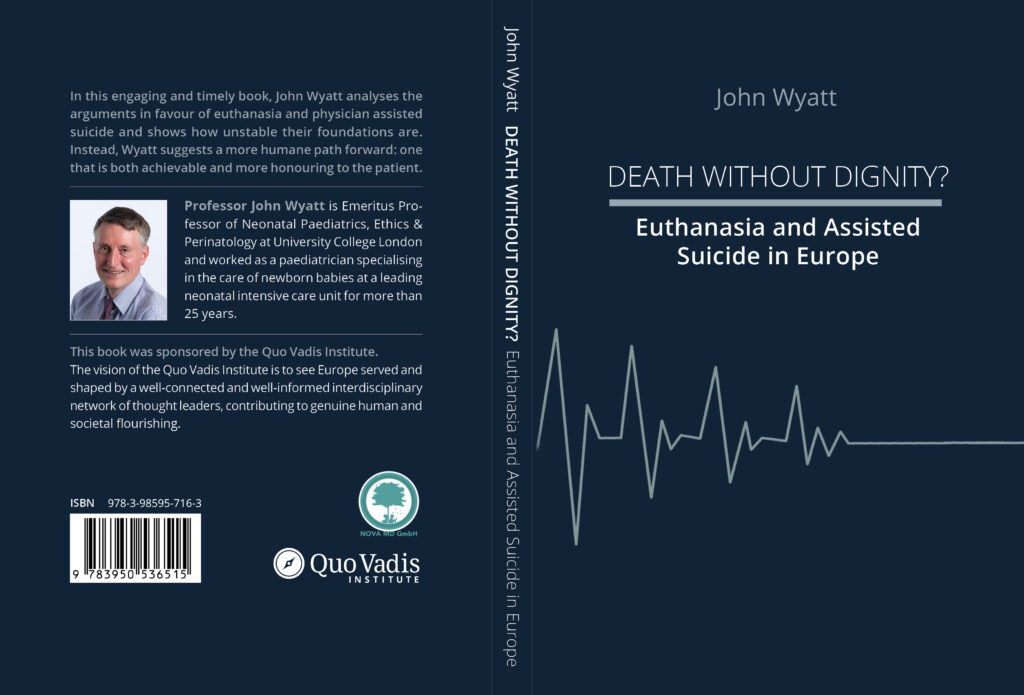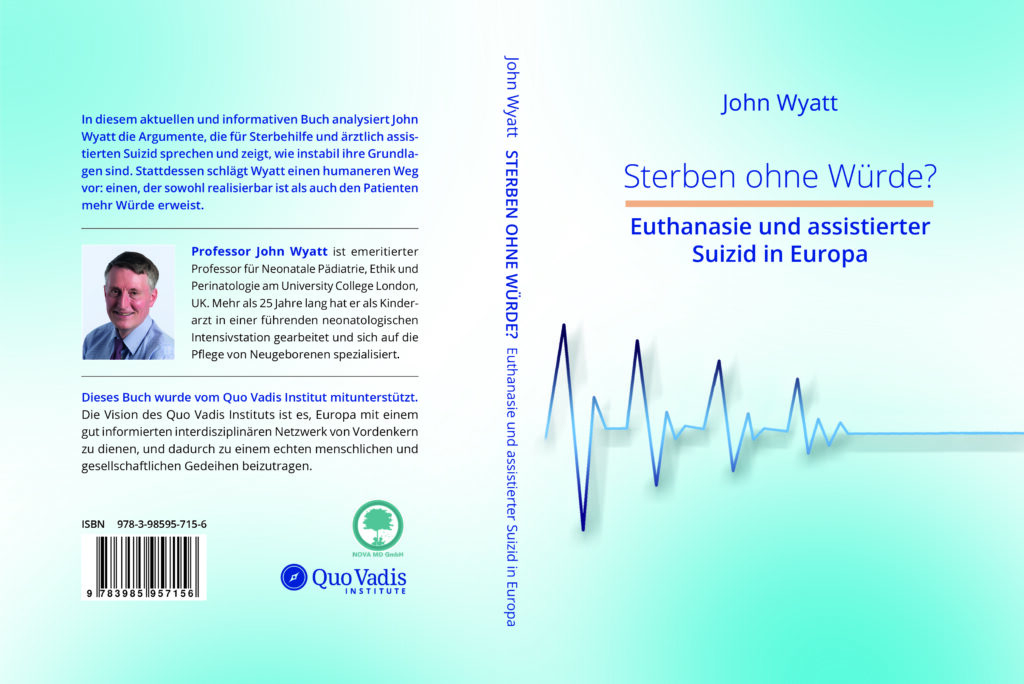
Is suicide always an act of despair and hopelessness or could it be a responsible way to die? Or is there a better way to die? Does modern palliative care provide a better, a richer, a more humane option?
John Wyatt, Death without Dignity, p. 7
Here (please scroll down) you can find the first chapter of John Wyatt’s book Death without Dignity?
In this chapter, you will read about four individuals who have experienced tragic stories and who have decided to end their lives in a medically way.
- Do you think these people chose a responsible way to die?
- Have you encountered someone who chose to end his or her life by euthanasia or medical assisted suicide?
If you wish to read the first chapter in English or German (with endnotes), please download the files via the button below.
English: Chapter 1 – Tragic Narratives

Deutsch: Kapitel 1 – Tragische Begebenheiten


About the Author: Prof John Wyatt
Professor John Wyatt is Emeritus Professor of Neonatal Paediatrics, Ethics & Perinatology at University College London and worked as a paediatrician specialising in the care of newborn babies at a leading neonatal intensive care unit for more than 25 years.
Visit Prof Wyatt’s website here: www.johnwyatt.com
More information on the distribution of the book can be found here.
Graphic Design of Book: Hanna Gawlas, Arkadruk.pl
Featured Image: Brandi Red, Unsplash
Chapter 1 – Tragic Narratives
An Assisted Death in Linz
In September 2020, a 36-year-old man came to the police station in Linz and reported that he had helped his friend to die. Police immediately went to his apartment and found the body of a 29-year-old man. The dead man had suffered from musculoskeletal pain for many years. He was known to have mental health issues and had made several suicide attempts in the past. His friend had promised to help him on this occasion and had obtained sedative medication at his request. He had taken an overdose late on Friday evening and had become comatose shortly afterwards. But on Saturday lunchtime he still showed signs of life. In order to keep his promise, the older man had placed a pillow against his friend’s face and suffocated him. The 36-year-old was charged with assisting a suicide and detained in prison.
Andrea Mielke
Assisted suicide was formally legalised in Austria in January 2022 and 57-year-old Andrea Mielke was the first person in Salzburg to opt for assisted suicide. She had been born with a rare genetic condition and had been a wheelchair user all her life. She had been a strong campaigner for the rights of disabled people and despite her physical limitations had many remarkable accomplishments. But she had decided that she could carry on no further. “I want the right to decide for myself when I end my life, when living is no longer possible.” The battle to achieve this right had not been easy, “If you’re not tough and brave enough, then you’ve lost anyway; because fighting the authorities is the worst thing and almost nobody can stand it.” Following her request, the Austrian law insisted on a 12-week cooling off period, before her request could be carried out, but eventually in April 2022, in the presence of her partner Adi and two doctors, she took lethal medication and ended her life.
Alzheimer’s Disease in the Netherlands
In September 2012, a 70-year-old woman living in the Netherlands was diagnosed with Alzheimer’s Disease. On the following month she signed a formal declaration. “When I shall be in a state in which my suffering is unbearable and hopeless or when there is no reasonable prospect to return to a state of life dignified for me or further loss of dignity for me is to be expected, I explicitly request my physician to administer to me or to provide me with the substances to terminate my life.” Over the following four years her mental condition deteriorated and in March 2016 she was confused and agitated. However, when asked by her physician whether she wishes to continue living she said “Yes, I do not want to die.” She repeated this several times. Still, at other times she appeared distressed and confused. In April 2016, her physician, supported by her relatives, administered a lethal injection, even though she appeared to be resisting the injection and needed to be restrained. The case caused considerable controversy and the physician was accused of violating the euthanasia legislation. Nevertheless, following a detailed investigation, the actions of the physician were supported in a 2019 judgement from the Criminal Court in The Hague and subsequently confirmed by the Supreme Court in 2020.
Daniel James
Daniel James was a promising young rugby player who had played for the England youth squad. In 2007, at the age of 22, he suffered a spinal cord injury while playing rugby and became permanently paralysed from the chest downwards. Daniel made an attempt on his life by swallowing an overdose of tablets whilst in the spinal injuries unit at Stoke Mandeville Hospital in England, seven months after his injury. Six weeks later he was discharged home and took a second overdose a few months later.
On that occasion, he was taken to hospital where a psychiatrist noted he was “very angry and extremely hopeless.” He was also despondent that he had again failed in his suicide bid. He refused any medical treatment but two days later was “calm, rational and co-operative.” He still maintained that he wanted to die and if he did not do so from his physical problems he would continue to attempt suicide.
His parents, who up until then had done everything they could to dissuade him, told the psychiatrist they had come to accept his wish to die. They had bought thousands of pounds worth of equipment for their home to help with his rehabilitation but he had shown no interest in using it. In March 2008, Daniel applied to go to the Dignitas centre in Switzerland telling his mother that if he were rejected, he intended to move out of the family home into assisted accommodation and starve himself, as “that was the only means of ending his life in a way that he was able to control.”
In September 2008, accompanied by his parents, he travelled to the Dignitas centre in Zurich where he took a lethal dose of barbiturates. His parents were quoted as saying, “His death was no doubt a welcome relief from the ‘prison’ he felt his body had become and the day-to- day fear and loathing of his living existence… This is the last way that the family wanted Dan’s life to end but he was, as those who know him are aware, an intelligent, strong-willed and some say determined young man.”
So here are four tragic true-life stories of people who desperately wanted to kill themselves because of severe illness, disability, suffering and despair. Surely it is time for a civilised society to provide a legal and medically assisted way for people faced with such terrible circumstances to choose to end their own lives?
We should always remember that the debate about euthanasia and assisted suicide is not only about complex legal, medical, ethical and societal issues. Above all, it is about individuals, desperate, suffering people who feel that their lives have become valueless because of serious medical conditions and who want to end their suffering by killing themselves. Why on earth should we not change the law to help people like these?
In the next chapter we look briefly at the wider historical context of debates about the ending of life.

